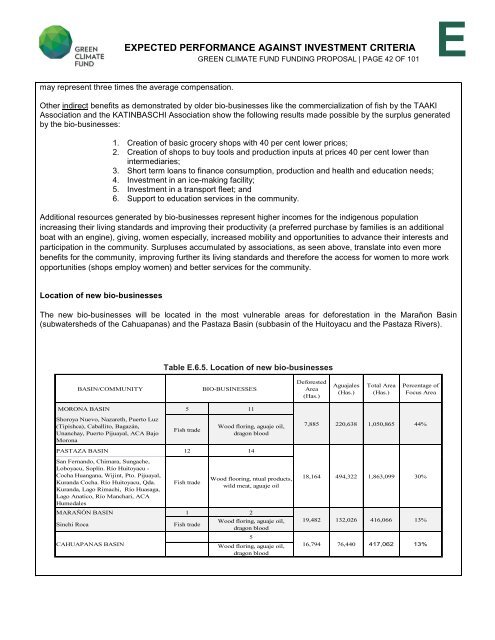proposals – Addendum
bf35cb34-05cf-4f96-a8fb-0adfa54cc3c9
bf35cb34-05cf-4f96-a8fb-0adfa54cc3c9
Create successful ePaper yourself
Turn your PDF publications into a flip-book with our unique Google optimized e-Paper software.
EXPECTED PERFORMANCE AGAINST INVESTMENT CRITERIA<br />
GREEN CLIMATE FUND FUNDING PROPOSAL | PAGE 42 OF 101<br />
E<br />
may represent three times the average compensation.<br />
Other indirect benefits as demonstrated by older bio-businesses like the commercialization of fish by the TAAKI<br />
Association and the KATINBASCHI Association show the following results made possible by the surplus generated<br />
by the bio-businesses:<br />
1. Creation of basic grocery shops with 40 per cent lower prices;<br />
2. Creation of shops to buy tools and production inputs at prices 40 per cent lower than<br />
intermediaries;<br />
3. Short term loans to finance consumption, production and health and education needs;<br />
4. Investment in an ice-making facility;<br />
5. Investment in a transport fleet; and<br />
6. Support to education services in the community.<br />
Additional resources generated by bio-businesses represent higher incomes for the indigenous population<br />
increasing their living standards and improving their productivity (a preferred purchase by families is an additional<br />
boat with an engine), giving, women especially, increased mobility and opportunities to advance their interests and<br />
participation in the community. Surpluses accumulated by associations, as seen above, translate into even more<br />
benefits for the community, improving further its living standards and therefore the access for women to more work<br />
opportunities (shops employ women) and better services for the community.<br />
Location of new bio-businesses<br />
The new bio-businesses will be located in the most vulnerable areas for deforestation in the Marañon Basin<br />
(subwatersheds of the Cahuapanas) and the Pastaza Basin (subbasin of the Huitoyacu and the Pastaza Rivers).<br />
Table E.6.5. Location of new bio-businesses<br />
BASIN/COMMUNITY<br />
BIO-BUSINESSES<br />
Deforested<br />
Area<br />
(Has.)<br />
Aguajales<br />
(Has.)<br />
Total Area<br />
(Has.)<br />
Percentage of<br />
Focus Area<br />
MORONA BASIN 5 11<br />
Shoroya Nuevo, Nazareth, Puerto Luz<br />
(Tipishca), Caballito, Bagazán,<br />
Unanchay, Puerto Pijuayal, ACA Bajo<br />
Morona<br />
Fish trade<br />
Wood floring, aguaje oil,<br />
dragon blood<br />
7,885 220,638 1,050,865 44%<br />
PASTAZA BASIN 12 14<br />
San Fernando, Chimara, Sungache,<br />
Loboyacu, Soplín. Río Huitoyacu -<br />
Cocha Huangana, Wijint, Pto. Pijuayal,<br />
Kuranda Cocha. Río Huitoyacu, Qda.<br />
Kuranda, Lago Rimachi, Río Huasaga,<br />
Lago Anatico, Río Manchari, ACA<br />
Humedales<br />
Fish trade<br />
Wood flooring, ntual products,<br />
wild meat, aguaje oil<br />
MARAÑÓN BASIN 1 2<br />
Sinchi Roca<br />
CAHUAPANAS BASIN<br />
Fish trade<br />
Wood floring, aguaje oil,<br />
dragon blood<br />
5<br />
Wood floring, aguaje oil,<br />
dragon blood<br />
18,164 494,322 1,863,099 30%<br />
19,482 132,026 416,066 13%<br />
16,794 76,440 417,062 13%


